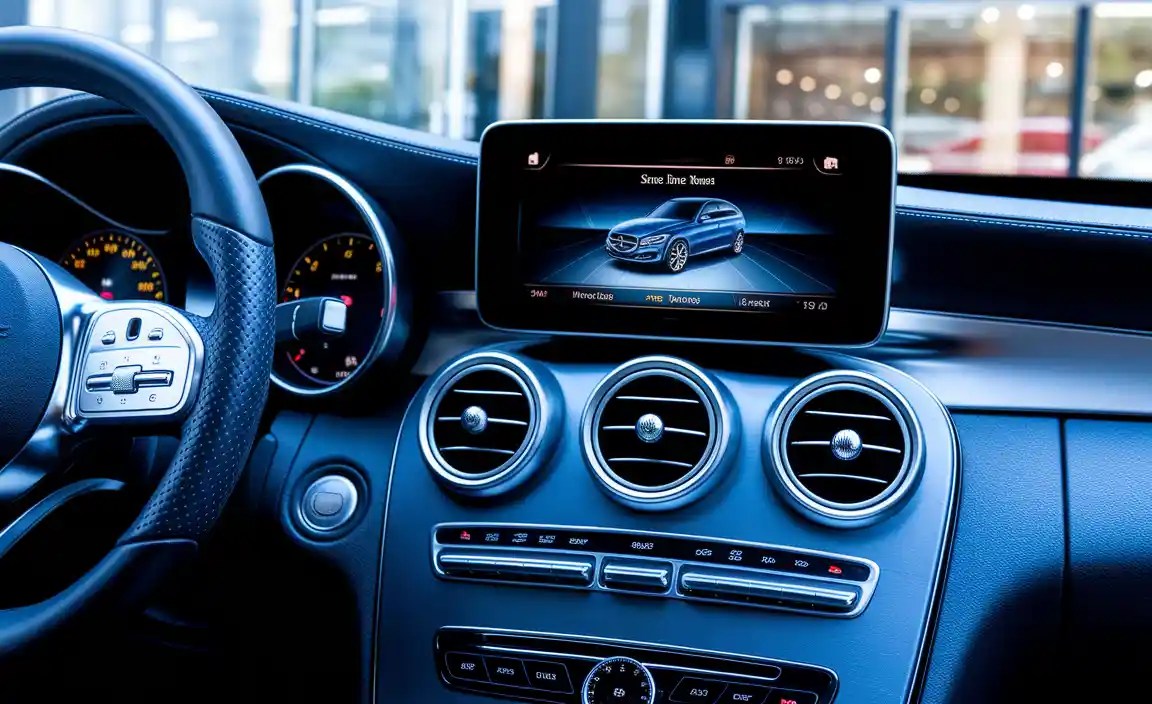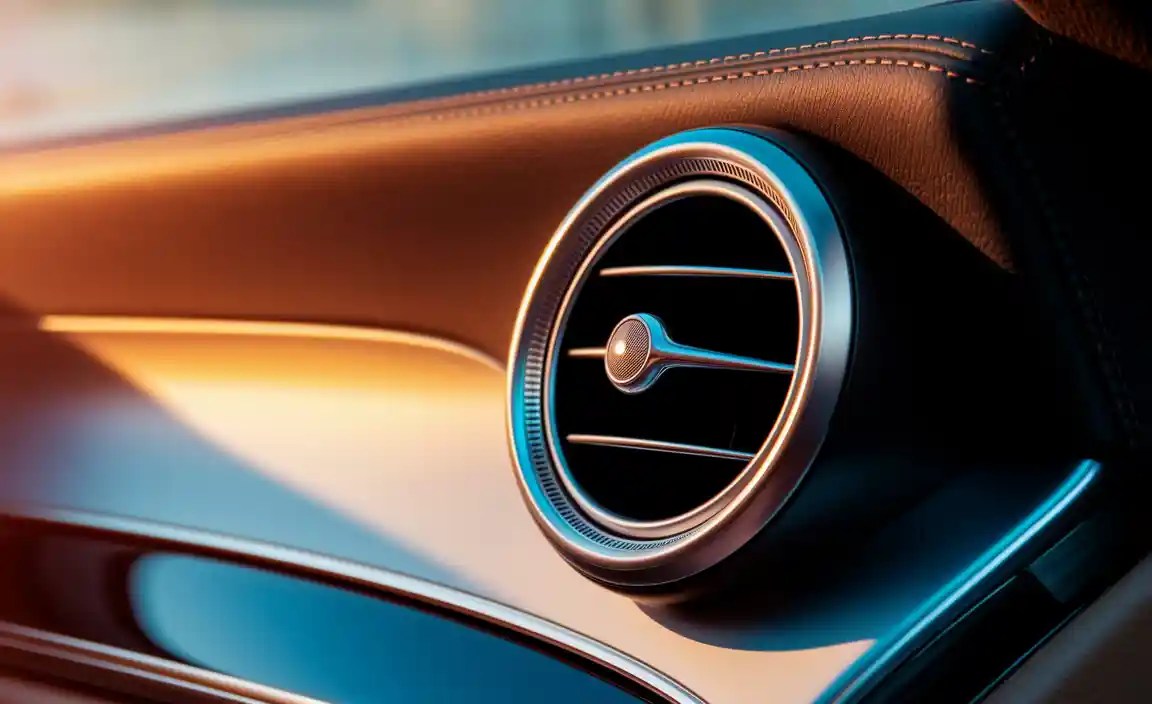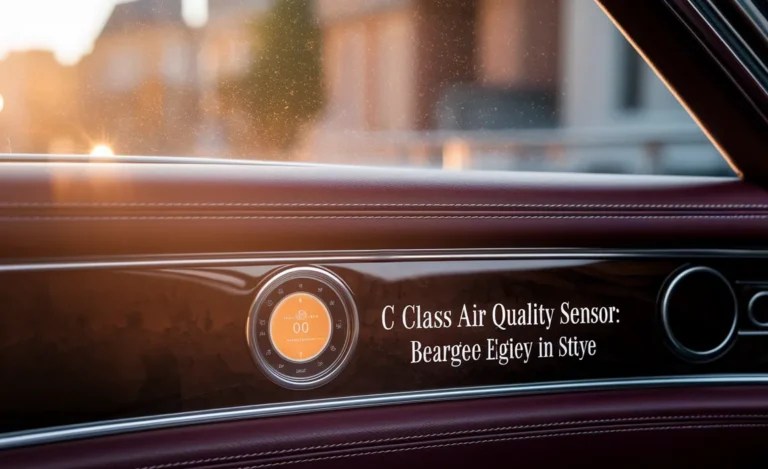Mercedes-Benz C Class Climate Vent: Perfect Luxury Comfort
The C Class climate vent system is cleverly designed to deliver an unparalleled level of cabin comfort, ensuring every drive in your Mercedes-Benz is a luxurious experience. Understanding its features and how to best utilize them allows you to fine-tune your environment for optimal relaxation and enjoyment. This guide will demystify the C Class climate control, showing you how to achieve perfect ambient settings with ease.
Welcome to MercedesBlue! Driving a Mercedes-Benz C-Class is an experience in refined comfort. A crucial part of this lies in its advanced climate control system, specifically the design and function of its climate vents. You might have noticed these sleek, often metallic, vents offering more than just airflow; they are integral to the car’s sophisticated interior ambiance.
Have you ever wondered why your C-Class air vents feel so substantial, or how they contribute to that signature Mercedes-Benz feeling of effortless comfort? Perhaps you’ve received a blast of air that felt just right, or a subtle, even distribution that kept you perfectly comfortable without feeling a draft. These nuanced experiences are by design.
This guide is here to demystify the C-Class climate vent. We’ll explore what makes them special, how they work in harmony with the rest of your climate system, and how you can best use them to achieve your personal perfect cabin temperature. Forget complex buttons and confusing settings; we’re going to make understanding your C-Class climate vent simple and enjoyable, focusing on the luxurious comfort it provides.
Let’s dive into how these crucial components contribute to the renowned luxury of your C-Class.

Understanding the C Class Climate Vent: More Than Just Airflow
The climate vents in a Mercedes-Benz C-Class are more than just simple outlets for air. They are meticulously engineered components, designed to blend seamlessly with the vehicle’s luxurious interior while delivering precise and comfortable airflow.

This attention to detail is a hallmark of Mercedes-Benz engineering, aiming to create an environment where every occupant feels pampered and perfectly regulated, regardless of external conditions.
The Design Philosophy: Form Meets Function
When you look at the dashboard of a C-Class, the climate vents often stand out. Whether it’s the turbine-style vents found in many modern C-Class models or the more traditional, yet equally elegant, designs in other generations, there’s a clear emphasis on aesthetics. These vents are crafted from high-quality materials, often featuring brushed aluminum or polished chrome finishes, contributing to the overall premium feel of the cabin.
The shape and placement of these vents are not arbitrary. They are strategically positioned to ensure optimal air distribution throughout the cabin. This means avoiding direct blasts of cold or hot air onto occupants, which can be uncomfortable, and instead promoting a gentle, even circulation.
Material Quality and Durability
The materials used in the C-Class climate vents reflect Mercedes-Benz’s commitment to quality. Unlike the flimsy plastic found in some vehicles, C-Class vents are typically made from robust metals or high-grade plastics that feel solid and durable to the touch. This not only enhances the tactile experience but also contributes to the longevity of the component. The satisfying click as you adjust an air-louver or the smooth rotation of a dial are small details that add up to a significant luxury experience.
Integration with the Overall Climate Control System
It’s crucial to understand that the climate vents are just one part of a much larger, sophisticated system. They work in conjunction with the:
Automatic Climate Control (THERMATIC or THERMOTRONIC): This system uses sensors to monitor cabin temperature, humidity, and even air quality, automatically adjusting fan speed, air intake, and temperature to maintain your desired settings.
Air Filters: High-quality cabin air filters ensure that the air entering the cabin is clean and free of pollutants, dust, and allergens, further enhancing passenger comfort.
Blower Motor and Evaporator/Heater Core: These components are responsible for producing and conditioning the air before it is distributed through the vents.
The vents’ design allows for controlled release of this conditioned air, ensuring it reaches all corners of the cabin efficiently and without creating uncomfortable drafts.
How C Class Climate Vents Enhance Your Driving Experience
The C-Class climate vents play a pivotal role in making every journey a pleasure. They go beyond simply heating or cooling the car; they are engineered to create a perfectly balanced microclimate that enhances your overall comfort and driving pleasure.

Directed Airflow and Zoning
Many C-Class models feature multi-zone climate control, allowing different temperature settings for the driver, front passenger, and sometimes even the rear passengers. The climate vents are key to this. They allow you to:
Direct Airflow: Easily adjust the louvers to direct air where you want it – towards your face, your feet, or a more general circulation.
Control Intensity: The size and design of the vents allow for fine-tuning the intensity of the airflow, from a gentle whisper to a stronger breeze.
Create Zoned Comfort: In multi-zone systems, the specific vents for each zone work together to independently regulate the temperature, ensuring everyone in the car is comfortable.
Reducing Drafts and Noise
A well-designed vent minimizes the creation of uncomfortable drafts. Instead of a harsh jet of air, the C-Class vents are designed to diffuse air smoothly. This is particularly important for maintaining a serene cabin environment. Furthermore, the quality of the materials and the precise engineering contribute to a quieter operation, reducing any distracting air noise and preserving the peaceful ambiance of the luxury interior.
Aesthetic Contribution to the Interior Design
As mentioned, the visual appeal of the C-Class climate vents is a significant factor in the car’s interior design. They are often conceived as “jewels” within the dashboard. The turbine-style vents, for instance, not only look striking but also provide a tactile and satisfying user experience when adjusted. This thoughtful integration of form and function elevates the perception of luxury and attention to detail.
Contributing to Defogging and Defrosting
Beyond comfort, the vents are essential for safety and visibility. Strategically placed vents, especially those near the windshield and side windows, are designed to direct airflow effectively for rapid defogging and defrosting. This ensures clear visibility in various weather conditions, contributing to a safer driving experience.
Optimizing Your C Class Climate Comfort: A Step-by-Step Guide
Achieving your ideal cabin temperature in a C-Class is straightforward once you understand the system. Here’s how to make the most of your climate vents:

Step 1: Understand Your Climate Control Interface
Most C-Class models feature either THERMATIC (a simpler, automatic system) or THERMOTRONIC (a more advanced, multi-zone automatic system). Familiarize yourself with the buttons or touchscreen controls:
Temperature Controls: Adjust the desired temperature using the ‘+’ and ‘-‘ buttons or by a slider on the screen.
Fan Speed: Control the intensity of the airflow. Often, an “AUTO” mode is available, where the system intelligently manages fan speed.
Air Distribution: Icons typically represent directing air to the face, feet, or windshield. Some systems allow for more granular control.
Recirculation Button: Use this to prevent outside air (and odors) from entering the cabin.
AC Button: Activates the air conditioning system for cooling and dehumidifying.
Step 2: Setting Your Preferred Temperature
Start with AUTO: For general comfort, the “AUTO” mode is excellent. It allows the system to automatically adjust fan speed and air distribution to reach and maintain your set temperature efficiently.
Manual Adjustment: If you prefer more direct control, set your target temperature. For example, if it’s 75°F (24°C) outside and you find 72°F (22°C) comfortable inside, set it to that.
Step 3: Directing Airflow for Maximum Comfort
This is where the vents themselves come into play.
For Heating: If the car is cold, you might want to direct warm air towards the occupants’ faces and upper bodies. Adjust the vent louvers so the air flows slightly upwards, or select the face distribution mode.
For Cooling: When it’s hot, you might prefer a more diffuse airflow to avoid a chilling sensation. Direct the vents slightly upwards or outwards, and consider using a lower fan speed once the desired temperature is reached.
For Defrosting/Defogging: Ensure the vents directed towards the windshield are open and set to a higher fan speed, with the AC on (even in winter, it helps dehumidify).
Feet Warming: For comfortable foot temperature, direct some airflow towards the lower vents.
Tip: Avoid pointing vents directly at your face or body with full force for extended periods if you find it uncomfortable. Gradual, diffused airflow is often more pleasant.
Step 4: Utilizing Recirculation and Air Filtration
Recirculation: Use this mode when you want to cool down or heat up the cabin faster, or if you’re driving through an area with unpleasant smells (e.g., traffic, agricultural areas). The system will then recirculate the already conditioned cabin air.
Fresh Air Intake: Regularly switch back to the fresh air intake mode to ensure a constant supply of oxygen and to prevent the air inside from becoming stale. Your C-Class likely has an advanced air filter to keep this fresh air clean.
For detailed information on your specific climate control system, always refer to your Mercedes-Benz owner’s manual.
Advanced Features and Technologies in C Class Climate Vents
Mercedes-Benz continuously innovates, and this extends to the subtle yet significant details like climate vent technology. While the basic function remains consistent, certain C-Class models may incorporate advanced features to further refine the cabin environment.

Ionization and Air Fragrance Systems
Higher trim levels or optional packages on some C-Class models might include advanced air purification features integrated with the climate system. These can include:
Ionization: The system can release negatively charged ions into the cabin air, which can help to neutralize airborne particles like dust, pollen, and even bacteria, leading to cleaner, fresher air.
ENERGIZING Comfort Control: This premium feature often integrates climate control with ambient lighting, seat kinematics, and audio to create specific moods and enhance well-being. The climate vents play a role in delivering the precise airflow and scents associated with these programs.
Active Fragrance System (Optional): Some C-Class models offer an integrated fragrance system that can infuse the cabin air with subtle, pleasant scents. The climate vents are the delivery mechanism for these fragrances, ensuring a consistent and gentle distribution.
Material Science and Ergonomics
The materials themselves are often chosen for their thermal properties and tactile feel. Some vents might feature:
Thermo-regulating Materials: While not common in standard vents, Mercedes-Benz is at the forefront of material science, and such features could be present in advanced applications.
Ergonomic Adjustments: The precision with which the louvers move and the ease of adjustment are testaments to the ergonomic design, ensuring that controlling your environment is intuitive and satisfying.
Integration with MBUX (Mercedes-Benz User Experience)
In C-Class models equipped with the MBUX infotainment system, climate controls, and sometimes even specific vent functions, can be managed through the central touchscreen or voice commands.
Voice Control: Phrases like “Hey Mercedes, I’m cold” or “Hey Mercedes, increase fan speed” can directly influence the climate system and, by extension, the airflow from the vents.
Touchscreen Interface: The climate control menus on the MBUX display offer a visually intuitive way to adjust all aspects of the system, including detailed directional airflow settings for different zones.
Here’s a table summarizing some advanced features and their benefits:
| Feature | Description | Benefit |
|---|---|---|
| Ionization | Releases negative ions to purify air. | Cleaner, fresher air; reduced allergens. |
| Active Fragrance System | Disperses subtle scents into the cabin. | Enhanced ambiance and well-being. |
| MBUX Integration | Control via touchscreen or voice commands. | Intuitive operation, enhanced convenience. |
| Multi-Zone Control | Independent climate zones for occupants. | Personalized comfort for everyone. |
C Class Climate Vent Maintenance and Care
Maintaining your C-Class climate vents is simple but important for ensuring optimal performance and air quality. Regular checks and minor cleaning can make a big difference.

Regular Cleaning of Vent Surrounds
The exterior of the vents can collect dust and smudges, detracting from the interior’s premium look.
What you need: Microfiber cloths, mild interior cleaner (approved for automotive use).
How to do it:
1. Lightly spray a microfiber cloth with an interior cleaner – do not spray directly onto the vent or dashboard, as liquid can seep into sensitive electronics.
2. Gently wipe down the vent surrounds, slats, and any control knobs or buttons.
3. Use a dry, clean microfiber cloth to buff any streaks.
4. For hard-to-reach areas, a soft detailing brush or a (Q-tip) can be useful for dusting.
External Resource: For guidance on approved interior cleaning products, consult resources from automotive detailing experts. A good example is the advice provided by major automotive clubs or detailing professionals, often found on their websites.
Checking and Replacing Cabin Air Filters
This is arguably the most critical maintenance task impacting your climate system’s performance and air quality. The cabin air filters trap dust, pollen, soot, and other airborne contaminants before they enter the cabin.
When to replace: Typically, cabin air filters should be replaced every 10,000-15,000 miles or annually, whichever comes first. Your Mercedes-Benz service schedule will have specific recommendations. If you notice reduced airflow from the vents, musty smells, or increased allergies during drives, it’s likely time for a replacement.
Where they are located: On most C-Class models, the cabin air filters are located behind the glove compartment.
How to replace:
1. Open the glove compartment. You may need to release clips or dampers to allow it to hang fully open.
2. Locate the filter access panel (often a plastic cover). Remove it.
3. Note the orientation of the old filters (there are usually two).
4. Remove the old filters and properly dispose of them.
5. Insert the new filters, ensuring they are oriented correctly with airflow arrows pointing in the right direction.
6. Reattach the access panel and close the glove compartment.
DIY Tip: While replacing cabin air filters is a common DIY task, if you’re unsure, your Mercedes-Benz dealership or a trusted independent mechanic can perform this service efficiently.
Checking for Blockages
Occasionally, small objects like coins, pens, or debris can find their way into the vents, obstructing airflow.
How to check: Visually inspect the vents using a flashlight.
What to do if blocked: If you see an obstruction, try to gently remove it with tweezers or a vacuum cleaner attachment. Be very careful not to push the object further in or damage the vent mechanism.
Frequently Asked Questions (FAQ)
Here are answers to some common questions about C-Class climate vents:
Q1: How do I make the air from the vents blow colder or warmer?
A1: Adjust the main temperature setting on your climate control panel. The system will then automatically regulate the airflow from the vents to reach and maintain that temperature, using the heating or cooling elements as needed.
Q2: Can I direct the air from the vents to specific areas?
A2: Yes, most C-Class models allow you to adjust the louvers on individual vents to change the direction of the airflow. Additionally, your climate control panel will have icons to select general distribution patterns like face, feet, or windshield.
Q3: My C-Class vents seem to have a plastic smell. What should I do?
A3: This is usually a temporary issue, especially in newer cars, as materials off-gas. Try running the system on fresh air intake with a medium fan speed for an extended period. Using the air ionization feature, if equipped, can also help. If the smell persists after a few weeks, consult your dealer.
Q4: How do I know if my cabin air filter needs changing?
A4: Symptoms include reduced airflow from the vents, a musty or unpleasant smell when the climate system is on, or if you experience symptoms of allergies more frequently while driving. Refer to your owner’s manual for the recommended replacement interval.
Q5: What are the turbine-style vents in some C-Class models?
A5: The turbine-style vents are a design element intended to mimic aircraft-inspired jet engines. They are highly aesthetic, often made of metal, and offer a satisfying tactile experience when adjusting airflow direction. They perform the same function as other vents but add a significant visual and premium feel.
Q6: Is the “AUTO” mode on my climate control effective?
A6: Absolutely. The “AUTO” mode is designed to intelligently manage fan speed, air intake, and air distribution to reach and maintain your desired temperature quickly and efficiently, while striving for quiet operation.






